Apple Announces The Apple Watch 4: Fully Custom SiP
by Andrei Frumusanu on September 12, 2018 11:30 PM EST- Posted in
- Mobile
- Apple
- Wearables
- Apple Watch Series 4
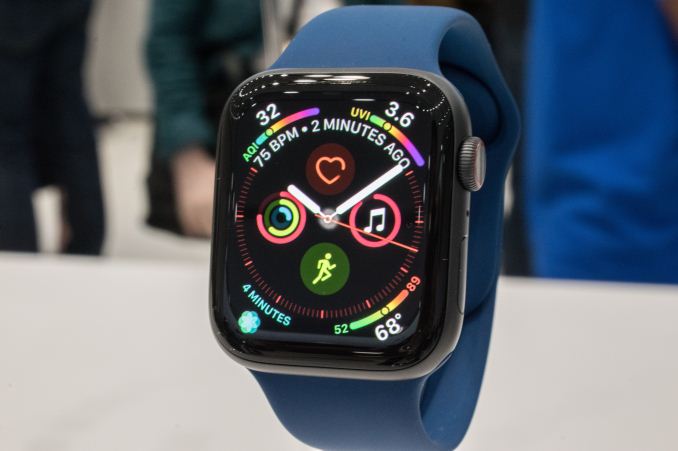
Today alongside the new iPhone XS, XS Max and the XR, Apple first introduced the new Apple Watch Series 4. The fourth generation of the watch sees a major revamp in its specifications and the most visible external design change to date.
Inside the new Apple Watch 4, we see Apple transition to a new SiP (Silicon in Package) design with a new S4 SoC containing for the first time a custom Apple designed CPU and GPU. We don’t have much information on the specifications here other than the new dual-CPU is 64-bit capable and is promised to perform twice as fast as it’s predecessors – which used Arm’s Cortex A7.
It’s to be noted that the 64-bit part of the new CPU might not be as clear as one might think, as there’s been some evidence (Credit @KhaosT) that the Watch might be running in ARM64_32 mode, which would be a 32-bit submode of AArch64 that allows for 32-bit pointers while retaining the ISA advantages of AArch64. Such a mode would be most optimal for a low-memory device such as smartwatch.
Prior generations of the Apple watch used a variation of an Imagination SGX core. For the S4 again Apple claims it’s a new custom GPU – again we don’t have any details here other than what Apple talked about in the presentation.
Finally the new S4 SiP includes new accelerometer and gyroscope functionality that has 2x the dynamic range in terms of measurable values, as well as able to sample data at 8x the speed. What this allows Apple to do is to collect a lot more data at higher accuracy and try to determine the scenario that you’re in. For example Apple claims the new watch is able to discern between falling, tripping and slipping just based on the movements that the person makes – whose detection is now enables by the new hardware sensor capabilities.
The new watch comes in 40 and 44mm sizes, and is fully compatible with prior generation Watch bands.
The core new characteristic of the new watch is the larger screen which now achieves a higher screen-to-body ratio on the watch. This is actually a pretty great improvement as the new screen feels a lot more pronounced.
To emphasize the new screen, Apple provides new watch faces with configurable information. Here the new watch allows for up to 8 complications which are at the disposal of the user. There’s also several new animated wallpapers available – these are pre-recorded videos that just play back on the watch face.
The new watch has also lost some of its thickness as it’s now 10.7mm versus the series 3’s 11.4mm. Here I’m still hoping one day we can see even thinner models, as it’s my personal least favourite aspect of smartwatches in general. Even though its thickness got reduced and it offers more performance and features, the new watch is said to maintain the same battery life longevity as its predecessors.
The sides of the watch have also changed quite a bit. On the left side we now have a larger speaker grill; Apple promises the new speaker to be a lot louder and surprisingly so for a watch. Unfortunately during the loud hands-on this was quite hard to evaluate.
On the right side we see the microphone being relocated between the button and the crown dial. The reasoning here is to reduce echo effects from the new more powerful speaker. The crown has been improved and now gives haptic feedback, trying to mimick the “clicking wheel” feel such as in more mechanical dials, or more aptly, the clicking of a mouse wheel when you scroll with it. The haptics here are enabled not by the crown itself, but by a vibration motor inside the watch.
On the back of the watch we don’t see much visible changes, however we now find a new improved optical heartrate sensor which is able to detect the heart rhythm.
What’s actually the most interesting in terms of the health monitoring capabilities of the new watch is that it actually includes for the first time ever a ECG (electrocardiogram) functionality in an over the counter consumer device. Here all you have to do while wearing the watch is to touch the crown – which serves as an anode and closes the loop created across your arms and heart.
Apple was very proud to be the first consumer device to enable this and had even received approval by the US FDA. It’s to be noted that this will beg some questions on how the feature will be implemented in other regions, as using and advertising such medical monitoring features might be disallowed if you don’t have regulatory approval.
Apple definitely is leading the smartwatch sector by a significant margin, and the company was even keen to point out that the Apple Watch is the most popular watch overall as well (Though that’s just because there’s no one dominating classic watch in a similar position).
The new Apple watch with GPS is available for $399 and the LTE variant comes in at $499 and are both available starting September 17th, with preorders starting this Friday the 14th. Overall I found the new Apple Watch 4 a lot more attractive than its predecessors – though it’s still a quite steep price point.


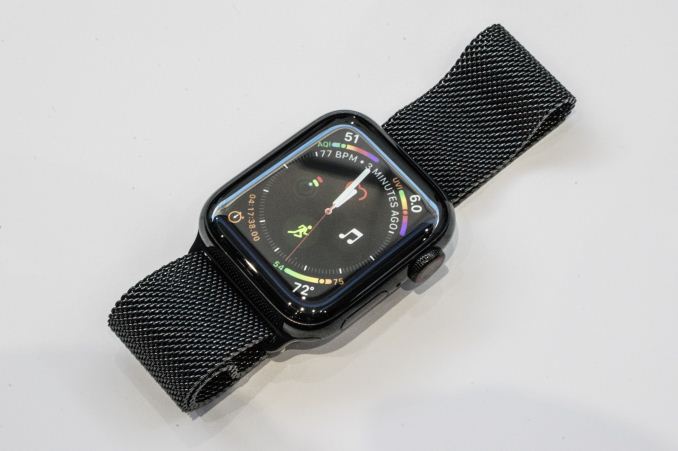
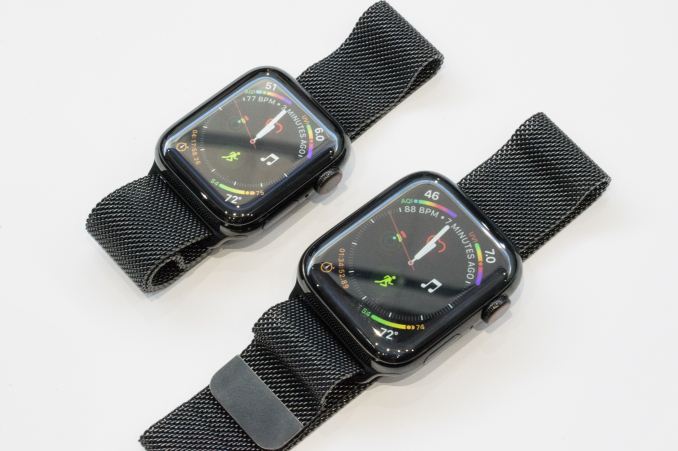
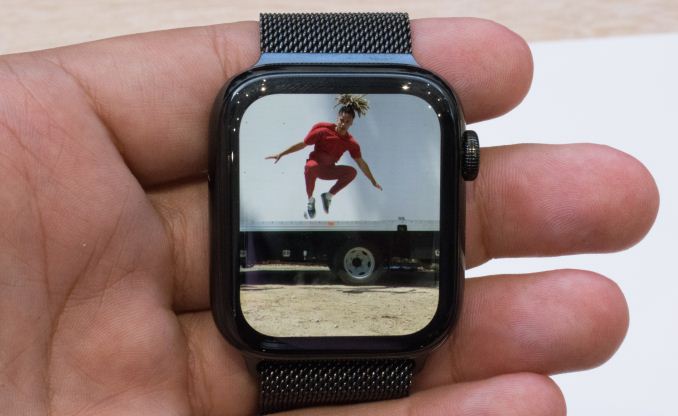
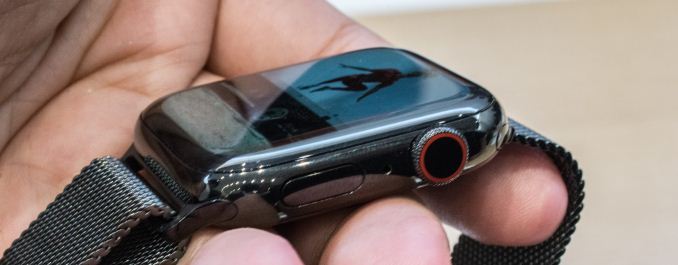









88 Comments
View All Comments
V900 - Friday, September 14, 2018 - link
Or maybe, juuust maybe, it’s because Apple keeps increasing prices, despite having the best profit margins in the industry as it is.solipsism - Saturday, September 15, 2018 - link
Apple is selling more device than FitBit even with FitBit selling their dumb, fitness tracker at considerably lower prices.• http://fortune.com/2018/03/01/apple-watch-fitbit-w...
V900 - Thursday, September 13, 2018 - link
The ECG may be FDA approves, but I doubt it’s abyehere near the same quality as a real ECG, that uses up to a dozen contact points on the arms and legs.id4andrei - Thursday, September 13, 2018 - link
Actually it is not FDA approved, it is FDA cleared which is not the same thing.repoman27 - Thursday, September 13, 2018 - link
According to Apple: "Apple Watch Series 4 is capable of generating an ECG similar to a single-lead electrocardiogram."It doesn't have a dozen leads, but that doesn't necessarily speak to the quality of the data it produces. The simplicity of this system could potentially eliminate a fair amount of procedural error. Plus there's the advantage of being able to take a reading whenever and wherever you think you might be having an issue, without having to go into a hospital, strip down, and have a dozen electrodes taped all over your body.
V900 - Thursday, September 13, 2018 - link
Dude, just stop right there.OF COURSE it isn’t as good as a real ECG.
There is a reason it hasn’t been FDA approved as a medical device.
And “procedural error”?!?
They have to strap on the electrodes to your hands and feet. That’s it! How dumb do you think your average hospital nurse is?
repoman27 - Thursday, September 13, 2018 - link
First, let me be clear that I in no way doubt the intelligence of nurses.Furthermore, the last time I was hooked up to an ECG, it was in the emergency room. Let's just say that I have a fair amount of body hair, and had recently lost several liters of fluid. There were quite a few people in the room working on me and the process did not go smoothly. At one point they thought they'd need to shave me to get the electrodes to stick and get an accurate reading, but there wasn't time for that. Basically it drove home the idea that these systems are not as foolproof as you might think in certain real-world hospital situations.
I also realize that the Apple Watch ECG would have been entirely useless in that situation. And the "procedural error" I had in mind was more to do with the correlation and interpretation of the data from the multi-lead systems anyway.
Apple's ECG app has been cleared by the FDA as a medical device. There is nothing about the app that would make it Class III or in any way eligible for the more stringent FDA approval process.
id4andrei - Thursday, September 13, 2018 - link
Medical device is a loose term in your context. A fitbit or a garmin is also a medical device by the same standards. Approval is not just what the device does but how well it does it. Clearance is basically not it.repoman27 - Thursday, September 13, 2018 - link
My context for the term “medical device” is precisely as defined by the FDA. Neither Fitbit nor Garmin have ever received sImilar FDA clearance for a wrist-worn ECG. Approval is for Class III and certain Class II devices, but has nothing to do with separating the “men from the boys” as you keep insisting it does. It’s merely the standard for devices that could directly harm an individual. Unless you swallow the Apple Watch, or use it to display images that trigger seizures, how is it going to directly harm you?V900 - Friday, September 14, 2018 - link
In most ECG systems made in the last couple of years, the machine also interprets the result, and let’s the person using it know if there is a problem, and what that problem is.That pretty much removes any chance of misreading the result.
As for “cleared by the FDA” yes, it’s been cleared by the FDA in the same way that the 19.99$ blood pressure reader at Walgreens have been cleared by the FDA.
In both cases: The 19.99 blood pressure reader and the $399 Apple Watch will get real life results that vary wildly in accuracy, and for that reason shouldn’t be used instead of getting a proper blood pressure reading or ECG.
It hasn’t been approved by the FDA, like a real ECG machine for hospital use has been approved for clinical use.